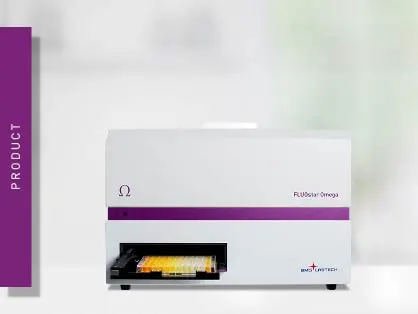
Omega Series
Upgradeable single and multi-mode microplate reader series


Discover how Ramona Hahn and the Koehler Group’s Environmental Analysis team revolutionized their wastewater testing process using the FLUOstar Omega microplate reader.

Ramona Hahn shows how reliable wastewater testing can be implemented on a microplate reader
Ramona Hahn is a laboratory technician at Koehler Group, a leading manufacturer of specialty paper products, known for its innovation and commitment to sustainability. The company produces a wide range of paper solutions, including thermal paper, flexible packaging paper and decor paper.
Paper production is a water-intensive process and generates wastewater due to various stages of manufacturing like pulp processing, chemical treatment during bleaching, staining or coating and finally for cooling processes and during the cleaning of machines.
Toxic substances in wastewater can destroy the biotic community inside a wastewater treatment plant. Wastewater testing is therefore important to ensure safe effluent discharges and appropriate wastewater treatments.
The bacterium Aliivibrio fischeri can be used for wastewater testing as its natural luminescence is reduced when in contact with toxicants. This behaviour of the bacteria was also employed in the process for wastewater analysis used to date at Koehler Group. Wastewater testing is typically done based on a dilution series of the samples to determine the dilution, at which the mean inhibitory effect on the viability of the bacterium is below 20 %, which is a prerequisite to be non-toxic enough to be injected into a wastewater plant. The resulting value is called ED20 – for effective dose or EC20 – for effective concentration. As the method and device previously used were no longer supported by the manufacturer, the team members in the Environmental Analysis department at Koehler Group were looking for an alternative way of analysing the wastewater samples produced. At Koehler, environmental responsibility and operational efficiency go hand in hand. For this reason, the search in this case no longer focused on a cuvette-based device as previously used, but this time on a microplate reader.
What role do microplate readers play in your work?
Actually, this is our first microplate reader. So far, we were using a dedicated luminometer, which can hold only one cuvette at a time. As we were trying to find a replacement of this device we decided to look into the field of microplate readers for this approach, also because we were hoping to increase the throughput of this measurement.
You have selected the FLUOstar Omega plate reader as central instrument in your laboratory for evaluating wastewater samples. What criteria did you base your selection on?
It was very important for us to find a device that was easy to use and had options for programming and automation. Our aim was to make the use of the device and the implementation of the method as simple as possible so that the measurement is accessible for a wide range of users who do not necessarily have a scientific background.
Reagent injectors enabled us to automate the addition of the assay reagent (including the luminescent bacteria), which promised additional time savings.
The modular device, which can also be applied for multiplexing approaches, further offered us the potential to establish additional methods.
The fact that BMG LABTECH is based in the immediate neighbourhood naturally also played an important role for us. The local conception, development and production of BMG LABTECH's microplate readers at its headquarters in Ortenberg, Germany are well in line with Koehler's philosophy of sustainability and operational efficiency. The cooperation during the transfer of the EC20/50 measurement method to the microplate reader worked very well and the knowledge and commitment of our contact person at BMG LABTECH, including a visit in our lab at Koehler Group, helped us to achieve quick and positive results.
With the FLUOstar Omega, you are using a microplate reader to analyse your wastewater samples for the first time. What advantages have you gained by switching to a microplate reader?
The most important advantage is the immense time saving. In contrast to our previous method, when it took up to 30 minutes to measure one sample, several samples can now be measured in parallel. By miniaturizing the approach into the wells of a microplate, we naturally also save on reagents. The automatic evaluation of the data by the MARS analysis software offers us additional time savings, as evaluation steps that have already been carried out for previous runs can be stored as templates and then automatically applied to newly generated data. The evaluation also offers us much more flexibility, as the software saves generated data automatically and the evaluation can therefore be carried out at a different time to the measurement itself.
A new method developed in collaboration with BMG LABTECH also improved the accuracy of the results for cloudy or coloured samples.
For more details on the method itself, you can check the application note “Wastewater testing using the biotoxic effect on the luminescent bacterium Aliivibrio fischeri”.
Ramona Hahn is a laboratory technician at Koehler Group. Her main tasks include environmental analysis of waste products which originate from various Koehler production lines. This includes measuring halogens and the EC20/50 value, to ensure safe effluent discharges and appropriate treatments of wastewater samples before they are fed into the Koehler’s own wastewater treatment plant.
Upgradeable single and multi-mode microplate reader series